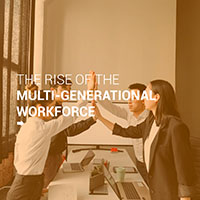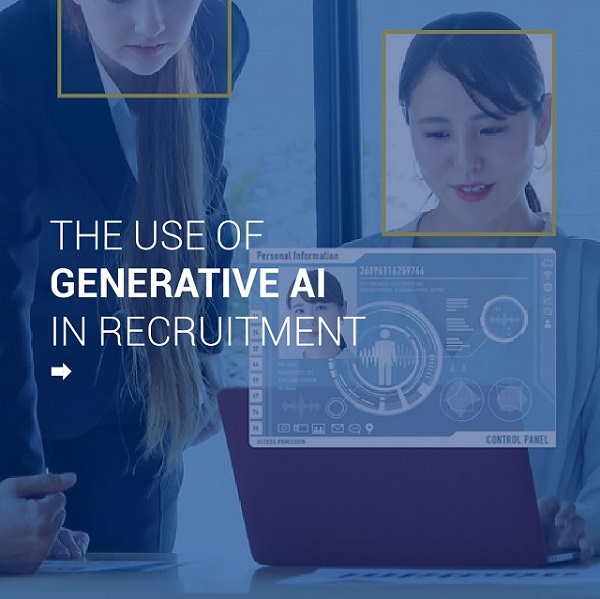7 Trends Employees and Employers in Japan Should Know in 2024
In the face of increasingly challenging economic climates, many companies in Japan find themselves at a crossroads, grappling with the dual pressures of uncertainty and the need for sustained growth. Within this volatility, the world of work has continued to evolve, and organisations are cautiously switching from simply keeping the lights on, to strategically planning for the future.
Today, employers and employees in Japan find themselves standing at the cusp of a transformative era, where the convergence of various factors is paving the way for unprecedented change. As more and more data emerge, we take a preliminary look into trends affecting the world of work in Japan, offering insights into how employers and employees can navigate this dynamic landscape with foresight and adaptability.
To better understand the road ahead, we polled 1,554 skilled professionals and 328 employers from Japan in our latest survey and investigated:
- What employers and employees can expect in 2024
- The hiring outlook
- The rise of the multi-generational workforce
- The importance of contracting
- Where everyone stands with flexible / remote working
- Rising roles in Tech
- The use of Generative AI in recruitment
Scroll down to continue reading or click on any of the sections below to jump straight to the topic you’re interested in!
Employers and employees in Japan are preparing for what’s to come
A prevailing trend in recent times has been the adoption of a more conservative outlook by some organisations, as they navigate volatile markets and economic instabilities.Faced with uncertainties such as global geopolitical tensions, trade disputes, and the lingering impacts of unforeseen events, many companies in Japan are choosing to be cautious, opting for prudent fiscal measures and a more restrained approach to expansion.
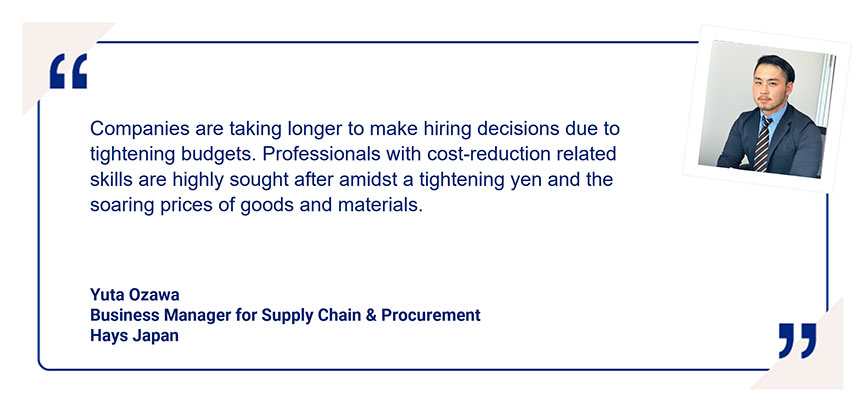
This has not gone unnoticed by the workforce, and employees across industries are acutely aware of the potential instability that accompanies the conservative approach adopted by some companies. Some workers, prioritising job security over ambitious growth, are opting for stability and resilience during uncertain times. The allure of a steadfast employment environment becomes particularly appealing as employees strive to safeguard their financial well-being in the face of perceived turbulence.
Simultaneously, a bolder contingent of workers is seizing the opportunity to negotiate better compensation packages with competitors. Recognizing the value of their skills in a competitive job market, enterprising professionals are on the lookout for better opportunities in the coming year to secure resources for the potential financial storm on the horizon.
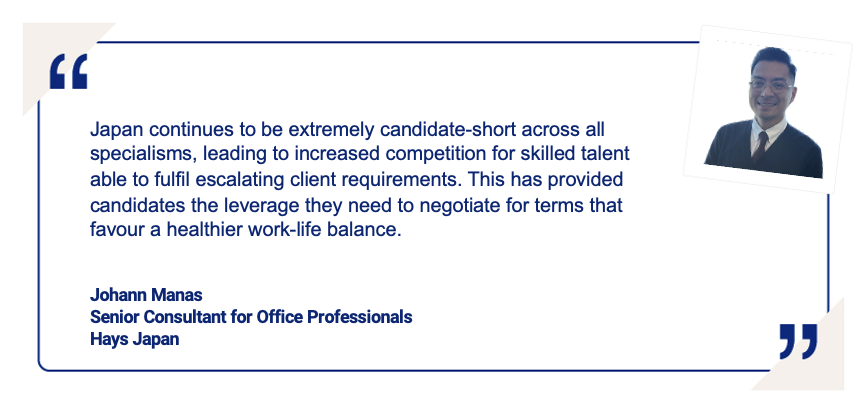
But companies in Japan are still hiring to meet growing needs
However, in stark contrast, a cohort of forward-thinking companies has emerged, embracing a dynamic and optimistic perspective despite the prevailing challenges. 47.3% of companies in Japan were confident of hiring candidates with the required skills over the next 12 months, proactively shaping their workforce strategies to thrive in the evolving economic landscape that lies ahead.
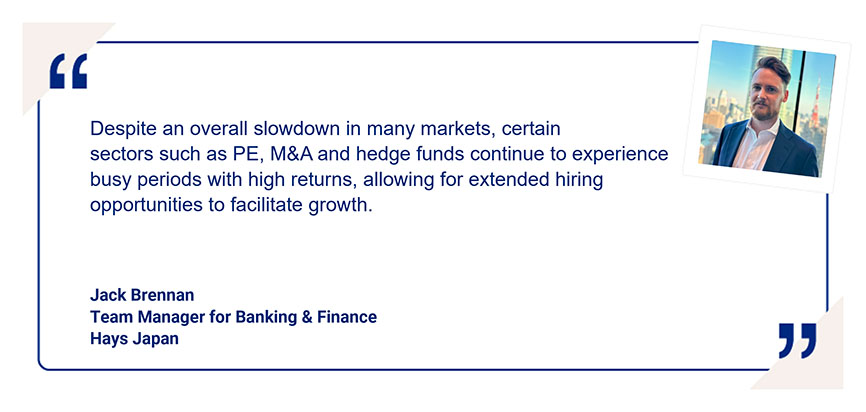
The demand for hiring in the upcoming period will be driven by persistent talent shortages prevalent across various industries. Presently, 62% of global senior decision-makers identify a scarcity of personnel possessing IT skills as a primary threat to their business. Given this current scenario, a substantial shift in hiring strategies becomes imperative.
With 75% of global recruitment professionals anticipating that skills-first hiring will be paramount for their companies, organisations must consider adopting the relevant approach in their talent sourcing. This means:
Defining and mapping skills by identifying the core technical skills needed across the organisation;
- Creating defined career paths and learning journeys based on skills gaps, not roles;
- Curating targeted learning interventions including formal training, experiential and mentoring/peer learning;
- Enabling internal talent mobility by posting key roles internally
Companies will have to manage a multi-generational workforce
With talent shortages almost a certainty in most sectors in the coming year, the need to broaden the scope for suitable resources grows ever more urgent. Millennials and Gen Zs are set to comprise over 70% of the global workforce by 2025, offering organisations a wealth of talent to pull from.
But how are companies responding to the shift in workforce demographics? In the upcoming year, persistent talent shortages will necessitate organisations to extract heightened performance from their multi-generational teams.
This has far-reaching benefits that organisations would do well to consider. Studies indicate that companies boasting a workforce with diverse age groups among their teams experience enhanced knowledge sharing, fostering improved problem-solving capabilities and decision-making processes.
Crucial to this endeavour will be the establishment of robust talent pipelining strategies aimed at attracting, securing, and engaging the most promising professionals across various stages of their careers. encompassing:
- Doubling down on efforts to hire more people early in their careers;
- Exploring opportunities to reengage the ‘unretiring’ populations;
- Training and reskilling those with experience across the organisation; and
- Exploring the opportunities of Hire-Train-Deploy models, whereby candidates are trained for specific skills requirements and armed for deployment at client sites.
Acquiring sought-after talent will demand organisations to extend their focus beyond a competitive pay strategy. They will need to consider factors such as job satisfaction, training, and career progression, adjusting these aspects to effectively support employees across diverse life stages.
Contracting is growing in importance
As the demand for flexibility during prolonged periods of uncertainty becomes more critical, contracting has emerged as a prominent solution. Everest Group observed a heightened dependence of organisations on flexible workforce solutions, encompassing freelancers and gig workers in their ranks. This trend is further fuelled by a growing segment of the labour force seeking additional income streams to cope with the escalating cost of living, which has become prevalent across Asia.
But contract workers are more than just a temporary solution to increased demand and cost cutting measures. The gap between critical new roles that have grown in relevance (such as tech, green and healthcare roles) that companies are looking to fill and the availability of talent possessing required skills isn’t one that can be easily plugged with traditional recruitment methodologies.

Whether you're looking for to fill a few gaps in your team or are rapidly expanding your flexible talent strategy through extensive contract workforce management, there are several essential considerations for organisations:
- Gather meaningful data so you can identify the skill gaps you need to address your challenges
- Work with your key stakeholders to develop a clear, cohesive strategy with well-defined metrics and desired outcomes.
- Embrace diverse approaches to talent acquisition to capture the best fit for your organisation.
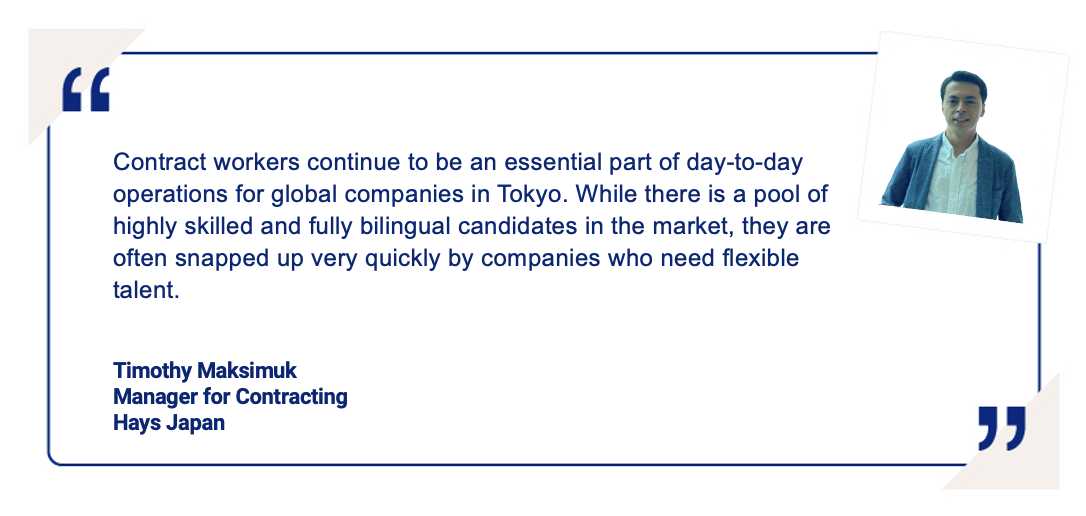
Staying flexible on flexible working
Japan is recently observing a rise in Covid again. Although far from the widespread pandemic that shook the world in 2020, social distancing measures is one among several reasons employees still desire to seek out flexible working options as an attractive employer benefit, where possible.
The Hays study observes that a higher percentage of employees in local companies have a fully on-site work arrangement as compared to those in multinational companies. There is an almost equal mix of multinational companies adopting a work arrangement of three days in the office per week and having a fully on-site setup. Among other Asian markets polled, employers in Japan have the highest percentage of fully remote workers, with 8.0% and 16.0% of employees in local and multinational companies working offsite, respectively. Japan also had the highest percentage of employees working between one and three days in office per month. This was in comparison to their counterparts in both local and multinational companies across Asia.
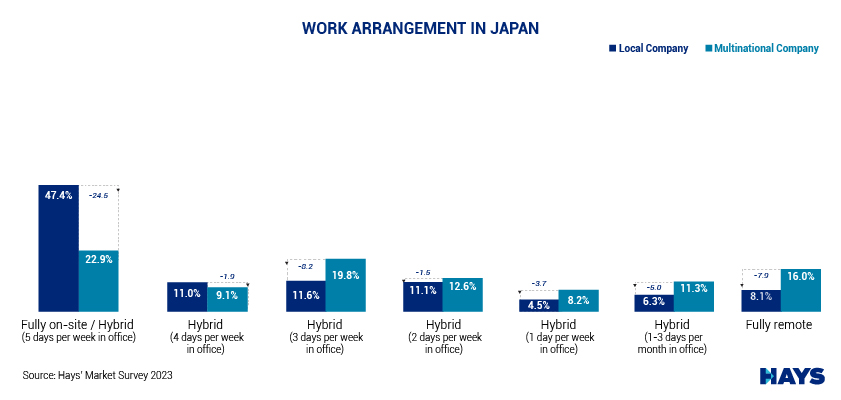
Of the employees surveyed, 66.7% of employees agree/strongly agree to the latest work arrangement policy. 37.3% received communications from their leaders suggesting that they believe culture and team morale can only be established through more face-to-face interactions. 19.1% indicate that their leaders perceive a decrease in collaboration on a day-to-day basis, while 16.9% state that their leaders perceive flexibility as leading to a decrease in overall productivity.
It is worth noting that the majority (65.0%) of employees who disagree with the latest work arrangement policy currently work fully on-site and four days per week in office. When asked to elaborate about who should establish the organisation’s work arrangement policy, opinions were divided among respondents. 28.5% preferred decision making to be made solely by their leadership, whilst 21.9% preferred a more decentralized decision making without leadership’s involvement. Among other Asian markets polled, Japan had a significant percentage of employees who believe they should have full control over their work arrangement policy.
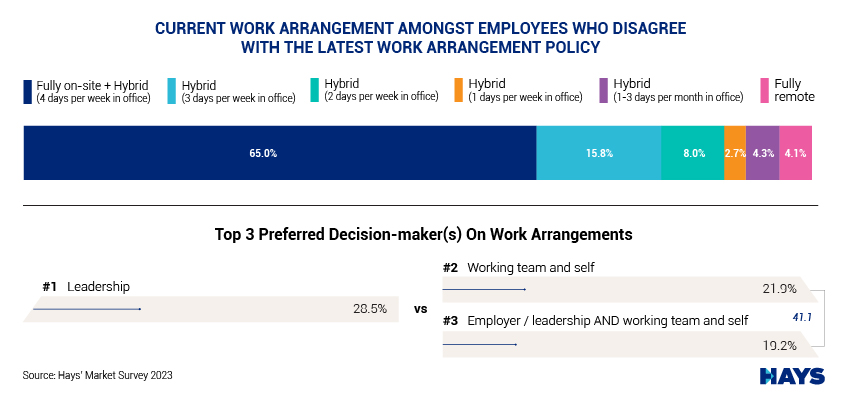
So where do we find balance? Recognising that dissatisfaction tapers off among workers with any option of flexibility is a good starting point from which to have a meaningful discussion. Facilitating open channels for flex work options throughout weeks and business peaks may be more important than specific number of in-office days per week considering that most employees are receptive to business priorities.
There are also productivity tools that organisations can use to optimise workforce output, both at the office and away from it for those limited days in a week or month. Platforms like Asana help boost collaboration within and between teams by centralising project discussions, making it easier for employees to share information, keep track of deadlines and stay accountable to deliverables. Tools like these are a good investment particularly within diverse talent teams encompassing a mix of contract, permanent or international employees.
Notedly, while flexible working is rated highly amongst the employer benefits, employees did not consider it among the top three reasons for leaving or staying in a company. Other factors such as career progression, seeking new challenges, salary, work-life balance, and fitting well with managers and colleagues are equally important. Consider these when putting together a strong Employee Value Proposition or engaging with employees on flex working discussions to attract new candidates and retain valuable ones.
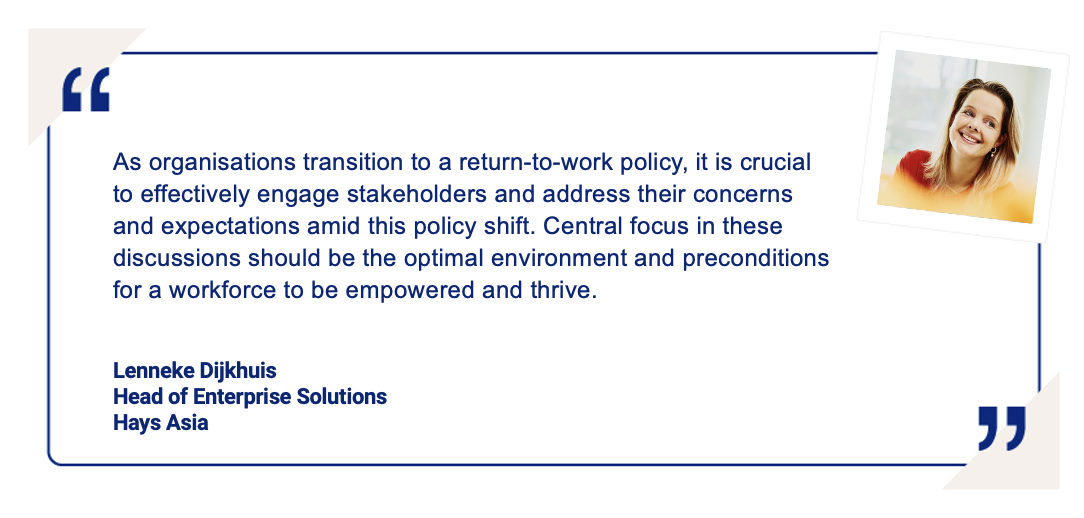
Success in the optimal work environment shouldn't rely solely on flexible options. It is equally crucial to acknowledge the importance of fostering a sense of belonging among employees, whether through organised on-site sessions or by orchestrating inclusive remote activities for the team. Be sure to review your policies on Diversity, Equity, and Inclusion to make sure they align with the evolving considerations entering the workforce, particularly concerning Gen-Z talent.
Tech jobs continue to dominate the landscape
Workplaces have witnessed numerous innovations in response to the evolving landscape, largely driven by technological advancements. The ramifications of digital transformation extend beyond mere app or web interface development to include the integration of cybersecurity measures for enhanced customer data protection.
Data analytics remains a cornerstone, furnishing companies with essential insights guiding pivotal decisions, while the increasing popularity of cloud migration aligns with both technical and physical considerations for server infrastructure. This steady stream of demand has given rise to a multitude of roles and opportunities, creating a burgeoning demand for skilled professionals.
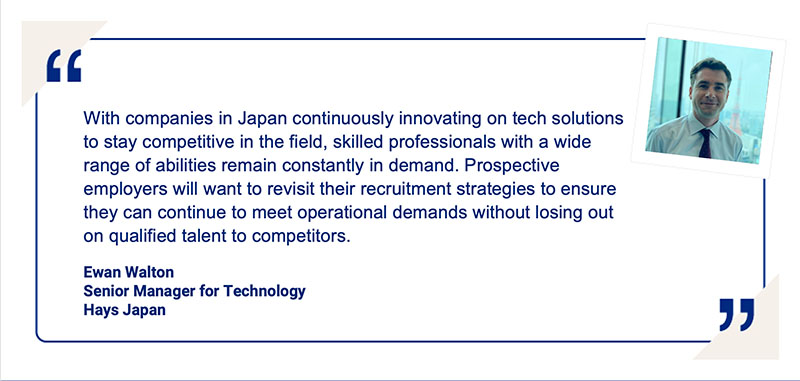
With automation, artificial intelligence, and data analytics playing pivotal roles in 2024, the tech industry is set to open numerous prospects for prospective employees, emphasising the ongoing and indispensable role of technology in shaping the world.
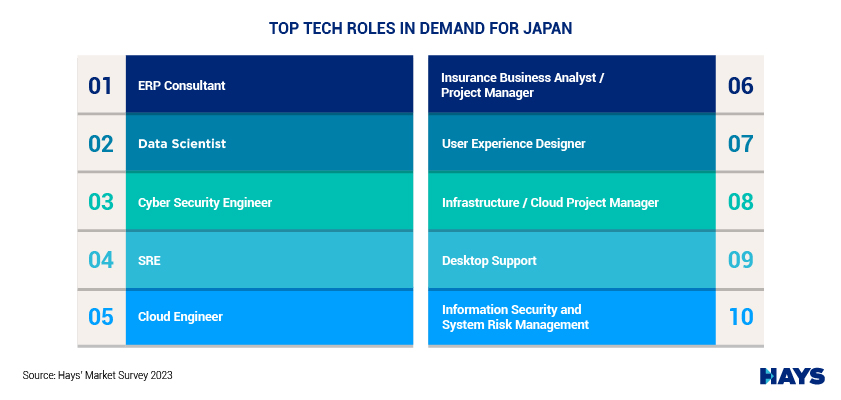
Employers and employees are embracing Generative AI in the recruitment process
Generative AI burst into the workplace in 2023, changing the landscape of work permanently. ChatGPT made headlines as the fastest-growing consumer application, achieving 100 million monthly active users within its initial two months; beating out rivals TikTok (9 months to reach this milestone) and Instagram (2.5 years).
While global CEOs have been keen to harness the power of Generative AI in the workforce, its usage in recruitment is still in the early stages. 16.2% of employers in Japan surveyed currently use AI minimally throughout the recruitment process, while 18.8% are only looking to explore it in the coming year. 51.5% have no plans to use AI in their recruitment processes yet.
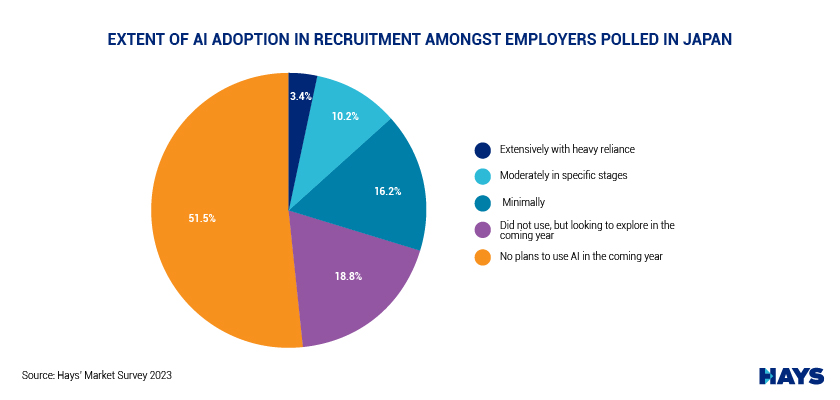
The top three applications among employers who used AI in recruitment are as follows: 34.2% used it to perform predictive analysis for candidate fit, 34.2% used it to assist with interview scheduling and coordination, while 27.8% used it for resume screening and shortlisting.
Despite a majority (68.8%) of human resources personnel polled supporting the use of AI tools to help them perform their tasks at work, just 29.6% of them believe their organisations have embraced AI sufficiently to stay relevant in the future.
Understandably, some of this hesitation comes from a lack of a standard regulatory framework, including budget – the latter being the primary challenge highlighted by employers in Japan when implementing AI in recruitment.
There is still much work to be done to bridge the gaps. 39.6% of respondents in Japan believe AI-powered resume screening can be biased and requires addressing before being utilised, whilst 40.0% believe it can be biased, but the biases are being addressed. This is unlike most of the China respondents who believe the biases are being addressed. The Hays study also found 21.5% of employers who used AI in recruitment are not actively assessing biases in AI recruitment tools while only 22.4% of human resources personnel polled received policies around the usage of AI tools from their manager(s) or organisation.
“Organisations have an active role to play in preparation for the increase AI implementation within recruitment. This involves close monitoring on the inherent biases with their vendors and to consider ethical considerations being addressed at the ASEAN level. Companies could leverage such strategic international collaboration to jointly and continually develop the necessary frameworks to adopt at a local level. This is particularly crucial in fostering trust in inclusive hiring, especially considering the expectations of both staff and candidates to utilise AI in recruitment or job-seeking processes,” said Marc Burrage, Managing Director, Hays Asia.
What’s next?
With the year only just beginning to shape up, we still have plenty more insights to share. Look out for the 2024 Hays Asia Salary Guide where we surveyed over 10,000 skilled professionals from China, Hong Kong SAR, Japan, Malaysia, Singapore, and Thailand for insight on how they’re navigating the evolving nature of work and talent sourcing for a complete picture of what employees and hiring managers can expect in the coming year.
Latest articles
Salary Guide
A comprehensive report providing you salary and recruitment trends to guide your talent strategy for the year
Register now
Start your job search by registering your CV and signing up to job alerts.
Salary checker
Find out how your salary compares with your peers in Japan to benchmark your current and future earnings.



